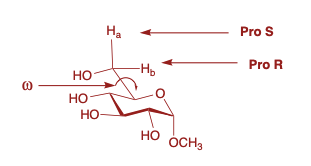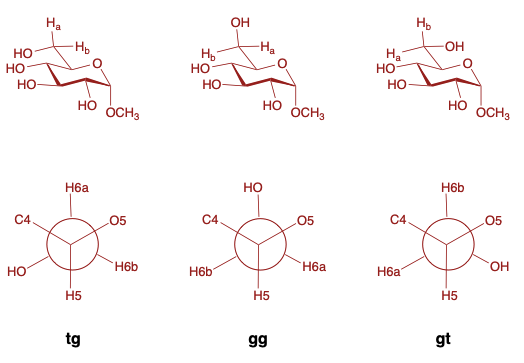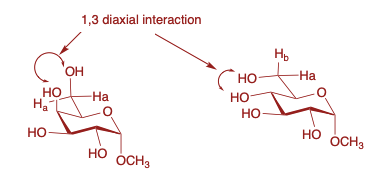Imagine a world where the sweetness of a candy, the stability of a drug, or even the recognition of a sugar molecule by a protein hinge on a tiny twist within its structure. This is the fascinating realm of hydroxymethyl group conformation in saccharides, where the subtle dance of a single group influences the very essence of these sugar molecules.
The Spinning Ballerina (hydroxymethyl group):
Picture the hydroxymethyl group (CH₂OH), attached to certain saccharides, as a graceful ballerina pirouetting in three main poses: gauche-gauche (gg), gauche-trans (gt), and trans-trans (tt). These conformations, defined by the relative positions of the C-H and C-OH bonds, are like different steps in the ballerina’s routine, each with unique consequences for the saccharide’s properties.
-Rotation about C-5/C-6 bond described by an angle – ⍵

Three possible staggered conformations ( Review: Book, K and J. Duus, J. J. Carbohydr. Chem., 1994, 13, 513-43).

- Each is named by listing the interaction between H-5 and Pro-S hydrogen (H-6a) followed by the interaction between H-5 and the Pro-R hydrogen (H-6b). In the first example, H-5 and H-6a are trans (t) and H-5 and H-6b are gauche (g). Hence tg.
- For sugar with axial OH at C-4 (galacto-, gluco-, talo- and ido-) the gg from is disfavoured (1,3 biaxial interaction between 4 OH and 6 OH).
- For sugar with equatorial OH at C-5 (gluco-, altro-, manno-, allo-,) the tg form is disfavored (1,3 biaxial interaction between 4 OH and 6 OH).

Secrets of the Twist:
This conformational waltz impacts saccharides in myriad ways:
- Hydrogen Bonding: Different conformations create distinct patterns of hydrogen bonding, affecting how readily a saccharide dissolves, interacts with other molecules, and even gets recognized by enzymes.
- Dipole Moment: The ballerina’s pose influences the molecule’s overall electrical charge distribution, impacting its attraction to other molecules and influencing properties like solubility and reactivity.
- Shape and Size: The twist alters the saccharide’s three-dimensional structure, affecting how it fits into binding pockets of proteins or interacts with its environment.
Unveiling the Dance:
Scientists employ various investigative tools to decode the secrets of hydroxymethyl group conformation. Nuclear Magnetic Resonance (NMR) spectroscopy acts as a keen observer, listening to the whispers of protons within the molecule and revealing clues about which poses the ballerina favors. Computational modeling steps in as a choreographer, simulating the conformational landscape and predicting the energy preferences of each twist.
Beyond the Basics:
The sugar story doesn’t end at these three static poses. The ballerina doesn’t just hold her positions; she gracefully transitions between them in a constant dynamic equilibrium. Factors like solvent, temperature, and neighboring groups influence this equilibrium, adding another layer of complexity to the saccharide’s behavior.
From Sweetness to Science:
Understanding hydroxymethyl group conformation isn’t just about indulging in the science of sugar. It holds immense potential for applications across various fields:
- Drug Design: Tailoring saccharide-based drugs to adopt specific conformations could enhance their binding to target proteins and improve their efficacy.
- Biomaterial Development: Designing saccharide-based materials with desired properties like stability or functionality relies on manipulating their conformational dynamics.
- Enzyme Engineering: Understanding how enzymes recognize different saccharide conformations can aid in designing enzymes with more specific or efficient sugar-processing abilities.
The Final Act:
Hydroxymethyl group conformation, once a hidden footnote in the saccharide story, emerges as a crucial plot twist. By understanding its intricate dance, we gain a deeper appreciation for the remarkable versatility and potential of these sweet molecules. As the curtain rises on future research, the secrets of the sugar twist promise to reveal even more fascinating chapters in the science of life.
